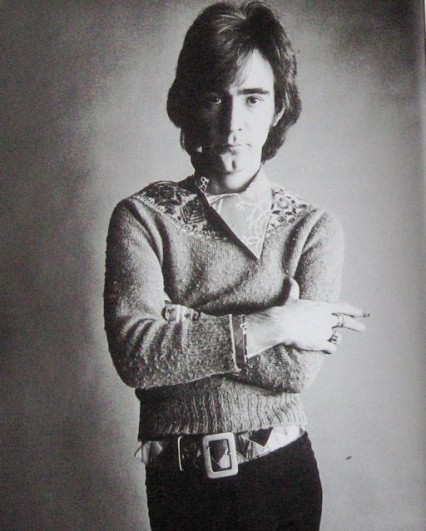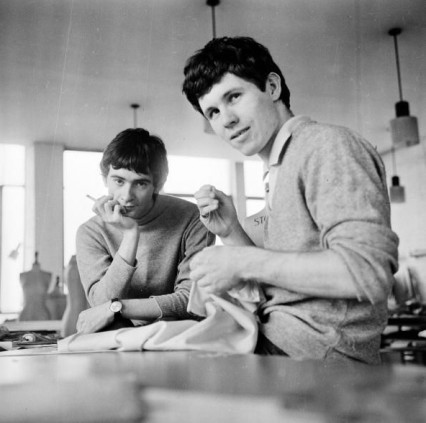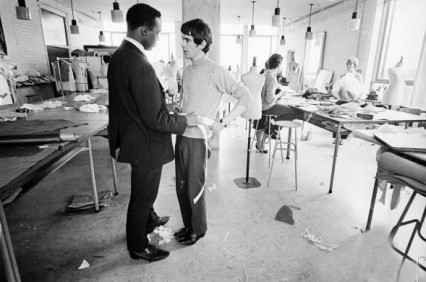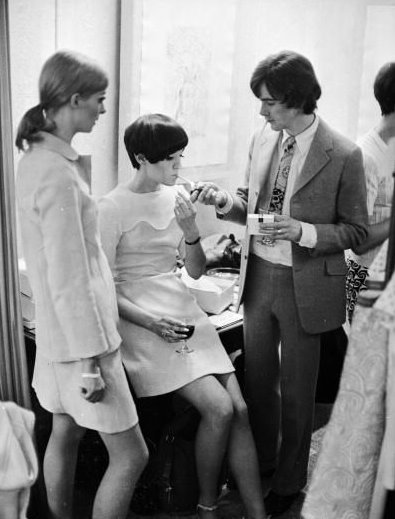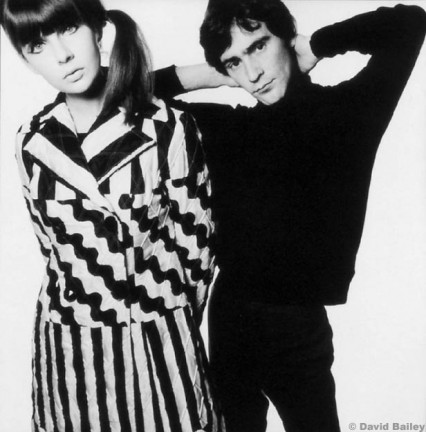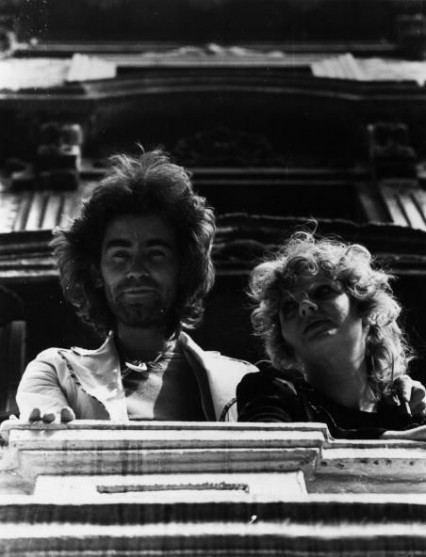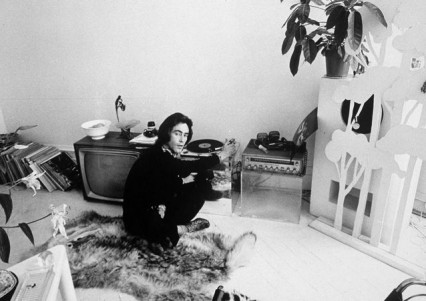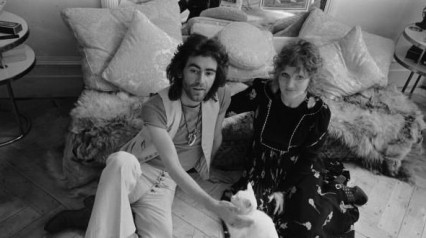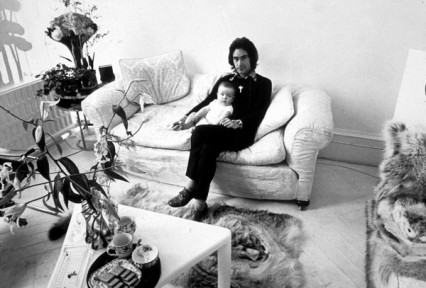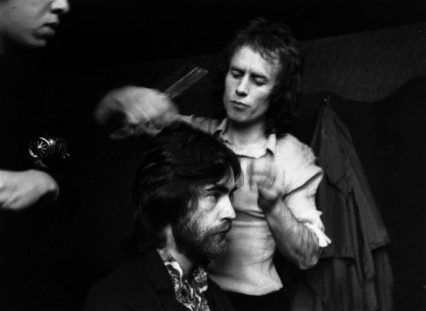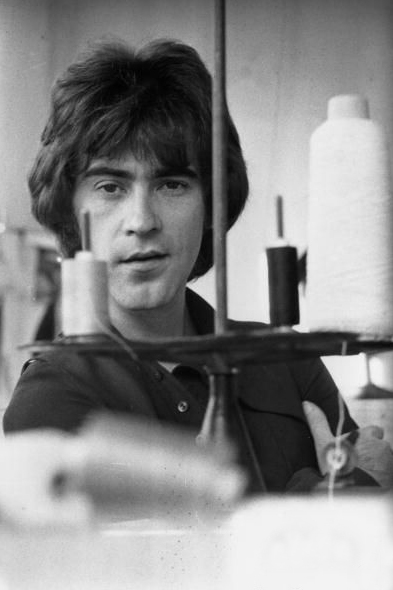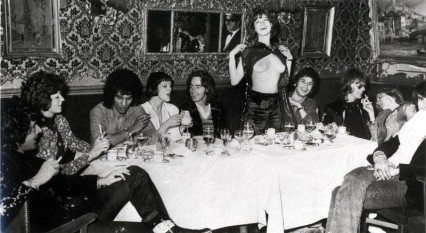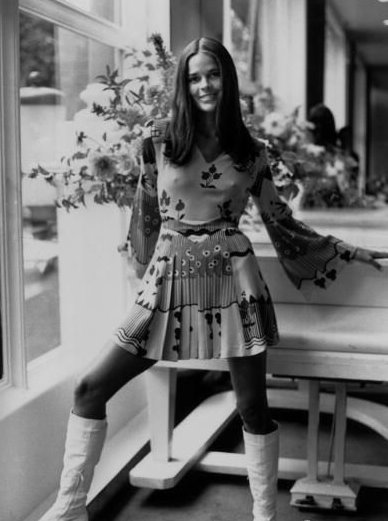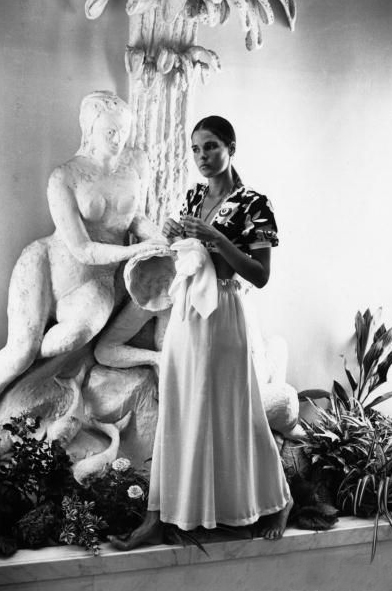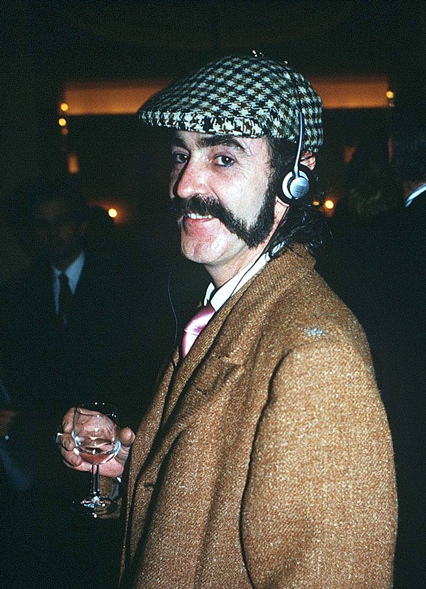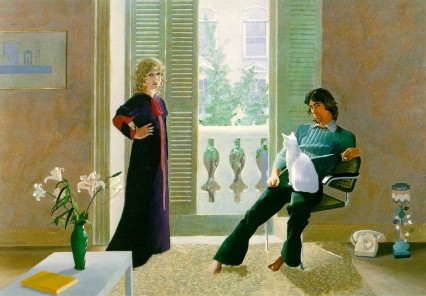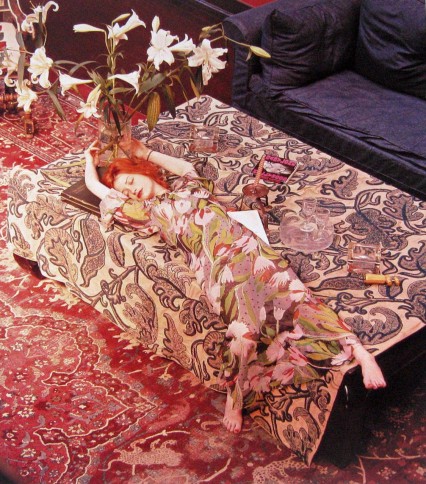In 1995 Ossie Clark, the iconic sixties and seventies fashion designer known for his flowing dresses and a rather excessive party lifestyle, invited the 27 year old Italian Diego Cogalato to move into his one-bedroomed Holland Park council flat in Penzance Street. Just eighteen months later, Cogalato called 999 and said to the operator ‘I think I’ve killed someone…’.
When the the police broke into the flat they found Ossie Clark on the floor with 37 stab wounds to his body and with his head completely stoved in, apparently by a large terracotta pot.
At the trial Coglato’s defence revealed that at the time of the murder he had been high on a mixture of Prozac and amphetamines – a combination of drugs that caused him to see himself as the New Messiah. Unfortunately they also caused Coglato to see Ossie Clark as a devil. A devil that needed to be extinguished. Coglato was convicted of murder but given just a six-year sentence on the grounds of diminished responsibility.
By the time he died, Ossie Clark was an unkempt and sad figure often wandering around Holland Park near his flat. He had become a buddhist and apparently prayed everyday in front of a shrine made entirely of empty packets of Sobranie cigarettes. His carpet was just brown cutting paper and his goldfish were kept in vases. He was so poor that he was occasionally seen scouring the streets for dog-ends to smoke and even fished pennies out of the fountain in Holland Park.
Just thirty years earlier, and ultimately to become one of Britain’s greatest fashion designers, Ossie Clark was at the beginning of his glittering career. In 1962 Ossie Clark moved to London to enrol at the Fashion Design School at The Royal College of Art. He graduated in June 1965, with a first class degree and a collection inspired by artist Bridget Riley.
Clark was an immediate success and he’d hardly graduated when Vogue magazine wrote about him as a major new talent and photographer David Bailey was hired to take his portrait.
Clark began to sell both his couture and ready-to-wear lines in the Chelsea boutique, Quorum with his friend and business partner Alice Pollock. Incidentally David Gilmore, later of Pink Floyd was a driver for Quorum for a while and later would provide a lot of music for Clark’s innovative fashion shows.
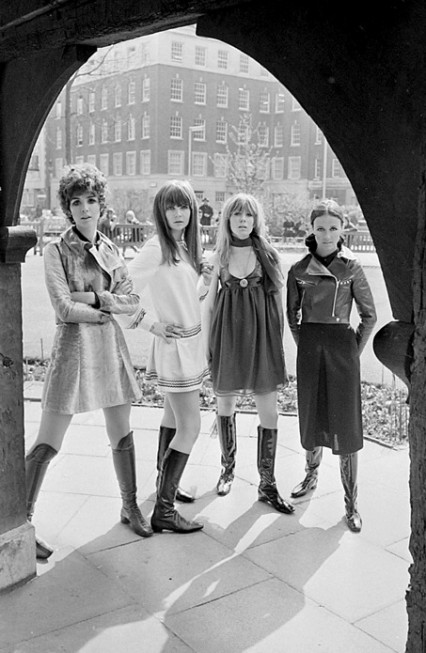
Linda Keith, Chrissie Shrimpton, Suki Poitier and Annie Sabroux displaying the Ossie Clark and Alice Pollock winter collection April 1967
Part of the success of Clark’s clothes at the time was due to the extraordinary collaboration with his wife, the textile designer Celia Birtwell. Many of Clark’s more famous garments were designed around her fabrics.
Clark had met Birtwell while they were both students in Manchester and although he was sexually attracted to men they became lovers, marrying in 1969 when she was pregnant with their first child. David Hockney, friend of the couple and sometime lover of Ossie, was the best man.
The marriage only lasted a few years – towards the end of the marriage Birtwell could no longer put up with Clark’s wild-partying, drug-taking and his many affairs with both men and women. She eventually had had enough and started an affair with the artist Adrian George, leaving Ossie for good in 1974.
David Hockney’s famous painting ‘Mr And Mrs Clark And Percy’ was given to the couple as a wedding present. Ossie, later in his life and needing the money, sold it to the Tate Gallery for just seven thousand pounds. It is now one of (if not the) most famous British painting and worth millions. Clark was always, despite his success, a very bad businessman.
During the decade before the separation however, Ossie Clark was the star of British fashion – even describing himself as a “brilliant butterfly”. He was particularly famous for his bias cut dresses and brilliant tailoring.
He had an incredible eye for the female form and thus created incredibly flattering clothes – it was said that he could cut a dress to fit a woman perfectly just be running his hands over her body. Marianne Faithful described trying on one of his dresses for the first time when she was eighteen -
“Ossie wanted everything to be on bare skin, so he said ‘Take it all off’ – and I did – the display was heart-tugging.”
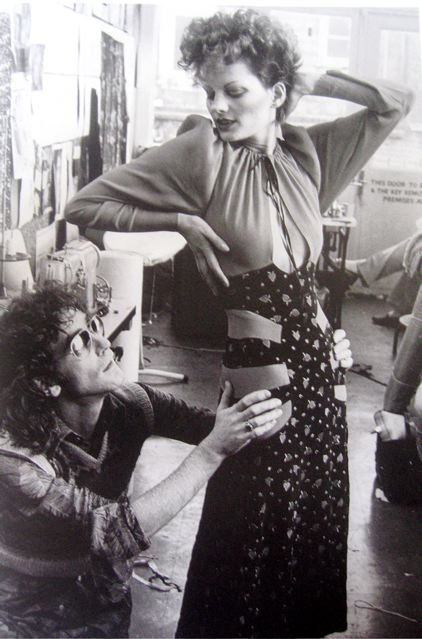
Ossie with Gala Mitchell his favourite model. 'It's all in my brain and fingers' he once said, 'I am a master cutter.'
By the early seventies Clark was at the height of his fame – his dresses were worn by the the most beautiful and famous women of the era – Patti Boyd, Ali MacGraw, Twiggy, Jean Shrimpton, Elizabeth Tayor and Liza Minelli. He even designed some of Mick Jagger’s stage costumes including the famous white jumpsuit he wore on the 1973 Exile On Main Street tour. If he was visiting New York he would hang out with Andy Warhol, Diana Vreeland and Truman Capote. He probably thought that life couldn’t get much better.
After the separation with Celia, Clark never really recovered emotionally and professionally and although the first entry in his diary in 1974 read:
January 10. Moved into Powis Terrace. Dinner with Mick and Bianca. Took Mo to cheer him up. After, Paul Getty Jr with Nikki Weymouth, Chrissy, Robert Fraser.
In the mid-seventies his fortunes went into a downward spiral, never a good business man, Clark now found his clothes decidedly unfashionable. The Kings Road was now enthralled with the punk revolution and its accompanying home-made fashion.
By 1983 Clark was declared bankrupt after the Inland Revenue claimed 14 years of back tax. He lost his house and had to live with friends until, eventually, the DHSS re-housed him in the small council flat in Penzance Street – the council flat where he was ultimately murdered.
Except for bits and bobs he never really worked properly again.
Denmark Street, The Rolling Stones, Vince Taylor And Denis Nilsen
Sunday, November 18th, 2007
Denmark Street – The Kinks
Down the way from the Tottenham Court Road
Just round the corner from old Soho
There’s a place where the publishers go
If you dont know which way to go
Just open your ears and follow your nose
Cos the street is shakin from the tapping of toes
You can hear that music play anytime on any day
Every rhythm, every way
You got to a publisher and play him your song
He says i hate your music and you hair is too long
But I’ll sign you up because I’d hate to be wrong
 Mick Jagger in the cramped recording studio December 1963
Mick Jagger in the cramped recording studio December 1963
In February they started recording their future single ‘Not Fade Away’ a cover of Buddy Holly’s original. They were in the middle of a gruelling tour and the group were tired, fractious and hardly speaking to each other – they’d almost given up working out how to record the song. Their manager Andrew Oldham phoned his friend Gene Pitney – the American music star, who was currently in London, for inspiration. Gene Pitney had written He’s A Rebel for the Crystals, Rubber Ball for Bobby Vee and was currently having a huge hit in the UK and the US with 24 Hours From Tulsa. Gene Pitney in London February 1963
Gene Pitney in London February 1963
 Sound studios when he made an unknown number of soundalike recordings for Woolworth’s own label Embassy Records. These included very reasonable covers of tracks such as Mungo Jerry’s In The Summertime and Stevie Wonder’s Signed, Sealed, Delivered, I’m Yours. In 1965, hopefully given a cup of coffee by the shy bespectacled office gopher, the American folk-singer Paul Simon walked into Mills Music one day proudly presenting two new songs he had recently written, The Sound of Silence and Homeward Bound. Unfortunately homeward bound was exactly where the man responsible for listening to new music sent him when he rejected the songs for being uncommercial and complicated. We can only hope that occasionally he and the man at Decca records who first auditioned The Beatles would meet up at their local pub, shake their heads sadly and wonder what might have been. Simon, after the rejection, decided to start his own publishing company called Charing Cross Music and has subsequently, and sensibly, kept the rights to all his music ever since.
Sound studios when he made an unknown number of soundalike recordings for Woolworth’s own label Embassy Records. These included very reasonable covers of tracks such as Mungo Jerry’s In The Summertime and Stevie Wonder’s Signed, Sealed, Delivered, I’m Yours. In 1965, hopefully given a cup of coffee by the shy bespectacled office gopher, the American folk-singer Paul Simon walked into Mills Music one day proudly presenting two new songs he had recently written, The Sound of Silence and Homeward Bound. Unfortunately homeward bound was exactly where the man responsible for listening to new music sent him when he rejected the songs for being uncommercial and complicated. We can only hope that occasionally he and the man at Decca records who first auditioned The Beatles would meet up at their local pub, shake their heads sadly and wonder what might have been. Simon, after the rejection, decided to start his own publishing company called Charing Cross Music and has subsequently, and sensibly, kept the rights to all his music ever since.
 met his first backing band – the Lower Third, and it was where he met Vince Taylor, the failed ‘leather rocker’. Vince’s real name was Brian Holden and he is known mostly these days for recording, as Vince Taylor and his Playboys, Brand New Cadillac, a song later of course covered by The Clash on London Calling. He had moved to France earlier in the decade and had become a leather-clad rocker and Elvis-like hero to French audiences. Taylor eventually became the inspiration for Bowie’s famous alter ego – “I met (Vince Taylor) a few times in the mid-Sixties and I went to a few parties with him. He was out of his gourd. Totally flipped. The guy was not playing with a full deck at all. He used to carry maps of Europe around with him, and I remember him opening a map outside Charing Cross tube station, putting it on the pavement and kneeling down with a magnifying glass. He pointed out all the sites where UFOs were going to land. He was the inspiration for Ziggy. Vince Taylor was a rock n roll star from the Sixties who was slowly going crazy. Finally, he fired his band and went on-stage one night in a white sheet. He told the audience to rejoice, that he was Jesus. They put him away.” By June 1972, the month that Bowie’s Ziggy Stardust album was released, Vince Taylor had managed to almost rebuild his career in France and brought out an album called “Vince is Alive, Well and Rocking in Paris” sadly not many people noticed he was still alive, let alone well and rocking, and after spending much of his life in prisons, psychiatric institutions and pretty much continually ‘out of his gourd’ he died in 1991 in Switzerland at the age of 52.
met his first backing band – the Lower Third, and it was where he met Vince Taylor, the failed ‘leather rocker’. Vince’s real name was Brian Holden and he is known mostly these days for recording, as Vince Taylor and his Playboys, Brand New Cadillac, a song later of course covered by The Clash on London Calling. He had moved to France earlier in the decade and had become a leather-clad rocker and Elvis-like hero to French audiences. Taylor eventually became the inspiration for Bowie’s famous alter ego – “I met (Vince Taylor) a few times in the mid-Sixties and I went to a few parties with him. He was out of his gourd. Totally flipped. The guy was not playing with a full deck at all. He used to carry maps of Europe around with him, and I remember him opening a map outside Charing Cross tube station, putting it on the pavement and kneeling down with a magnifying glass. He pointed out all the sites where UFOs were going to land. He was the inspiration for Ziggy. Vince Taylor was a rock n roll star from the Sixties who was slowly going crazy. Finally, he fired his band and went on-stage one night in a white sheet. He told the audience to rejoice, that he was Jesus. They put him away.” By June 1972, the month that Bowie’s Ziggy Stardust album was released, Vince Taylor had managed to almost rebuild his career in France and brought out an album called “Vince is Alive, Well and Rocking in Paris” sadly not many people noticed he was still alive, let alone well and rocking, and after spending much of his life in prisons, psychiatric institutions and pretty much continually ‘out of his gourd’ he died in 1991 in Switzerland at the age of 52.I’m not sure if Denis Nilson, the infamous serial killer who murdered at least fifteen men in his flat in North London, had a musical note in his body but for some time in the late 1970s and early 80s he worked at the Job Centre at 1 Denmark Street. In 1980, which would have been right in the middle of his killing spree, he offered to help with the food for the office Christmas party and brought along a huge saucepan. Former colleagues only realised during the trial that this was the same saucepan that had been used to boil the heads of several of his victims.
in North London, had a musical note in his body but for some time in the late 1970s and early 80s he worked at the Job Centre at 1 Denmark Street. In 1980, which would have been right in the middle of his killing spree, he offered to help with the food for the office Christmas party and brought along a huge saucepan. Former colleagues only realised during the trial that this was the same saucepan that had been used to boil the heads of several of his victims.
